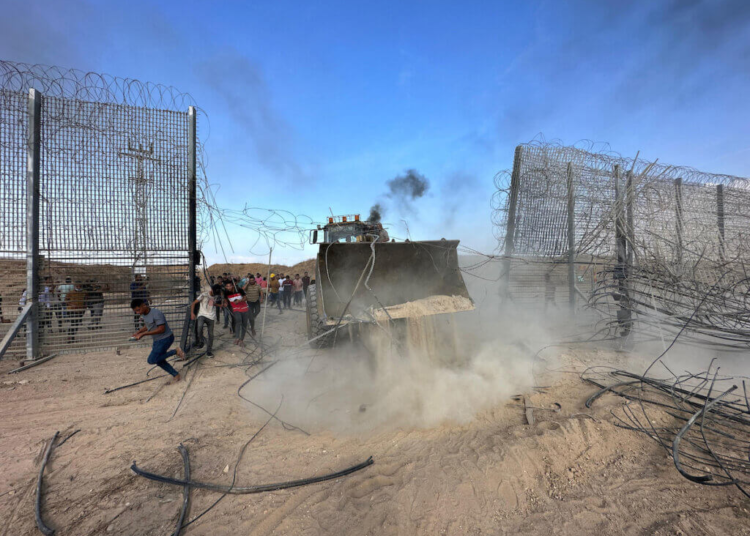The conflict in Gaza has tragically resulted in the loss of lives of over 12,000 Palestinians and severe infrastructure damage inflicted throughout the strip. Yet, for many, a significant question persists – why did Hamas abruptly deviate from its established norms of engagement with Israel and broke the rules of the game? Disregarding conspiracy theories and potential instruction from third parties, it is crucial to explore the pre-incident situation in Gaza to accurately interpret such a shift in tactics.
Internally, Palestinian politics were pervaded by a deepening deadlock, with Mahmoud Abbas vehemently resisting elections due to perceived threats of Fatah-endorsed candidates facing defeat in the West Bank and Gaza Strip. Simultaneously, Israel demonstrated little interest in negotiating with Palestinians; the ascendance of right-wing parties expedited the Judaization of Al-Quds and bolstered West Bank settlements. Moreover, the escalating mistreatment of Palestinian prisoners, extreme policies at Al-Aqsa Mosque, increased detentions in the West Bank, and the tightening blockade of Gaza essentially conjured an image of slow attrition for Palestinians, particularly those in Gaza.
On a regional level, the dialogues between Saudi Arabia and Israel signaled the impending establishment of official relations, a development detrimental to Palestinian interests. Given that Saudi Arabia stands as a paramount Arab country, its potential alignment with Israel, echoing previous alliances formed by the UAE and Egypt, signifies a significant abandonment of Palestine. From Hamas’ perspective, the success of Israeli Prime Minister Benjamin Netanyahu and his radical government in the field of foreign policy would equal an increasing capacity to oppress Palestinians in Al-Quds, the West Bank, and Gaza Strip, mandating a preemptive counter-strategy.
Historical experiences augmented these concerns. Notably, the simultaneous assassinations of several commanders from the Liberation Organization’s military wings during the 1990s Oslo peace talks led to suspicions of similar plots, particularly targeting senior Hamas officials, coinciding with the normalization of Saudi-Israeli relations and likely political negotiations. In this regard, there were even reports and assessments that senior Hamas officials, including Mohammad Deif, Marwan Issa, Yahya Sinwar, Saleh al-Arouri and Ismail Haniyeh, were to be physically eliminated with the change of political balance. Reports suggested that this could pave the way for subsequent Israeli actions in Gaza, sans the influential leaders of the Palestinian resistance forces. Against this backdrop, the Al-Aqsa Flood operation on October 7, not only thwarted any surprise plan by the Israelis but delivered an unexpected blow to Israeli security and political authorities.
This intricate matrix of internal and external challenges presented Hamas with two golden opportunities, the postponing of which could have had irreparable consequences. On the one hand, Israel was faced with a political crisis that was unprecedented in the history of this regime. This crisis had lasted for about 6 months and had sparked widespread street protests in Tel Aviv and other important cities. This political crisis reached a point where parts of Israel’s military forces in the army and security apparatus joined the ranks of the opposition to Netanyahu’s cabinet or disobeyed orders, which had never happened before. It is within this context that Hamas’ unexpected deviation from the longstanding rules of engagement with Israel can be best understood.
Nevertheless, less than a fortnight prior to the Al-Aqsa Flood operation, there was a substantial security leak from the Israeli security, intelligence and military sectors. This highly sophisticated cyber-attack, reputed to be the largest of its kind against Israel, made a wealth of information from one million Israeli soldiers, including personal details, educational qualifications and employment records, accessible. The exploitation of this rich cache of intelligence enabled Hamas to access strategic resources, leading the movement’s leadership to the conclusion that a high-stakes decision was needed to break the current impasse.
Given this particular context, wherein the challenges and opportunities struggling before Hamas made persevering in the status quo near infeasible, a couple of anticipatory assumptions may be proposed. Firstly, it is possible that Hamas was banking on the notion that the United States would, given the existing discord between the US President Joe Biden and Prime Minister Netanyahu, hesitate to provide enough support for Israel. Secondly, they may have hoped that Israel, wary of the potential risk to the captives, would engage in negotiations following the initial round of attacks. However, the blow inflicted upon the Israeli security and military framework was so potent that it induced seemingly irrational behavior from the regime.
Nonetheless, certain Arab analysts argue that Hamas likely anticipated such a development, and they likely expected Israel to decimate Gaza using the Dahiya strategy, as constructed by one of the Israel’s top military commanders, Gadi Eisenkot, in 2006. They postulate that given the political stagnation in Palestine with a dark prospect ahead, and potential normalization between Saudi Arabia and Israel favoring Tel Aviv, undertaking a significant operation, despite its inherent risks, became an unavoidable pathway for Hamas.
Contrary to the triumphalist narratives propagated by pro-Israel current that equate the military’s incursion into the Gaza Strip with victory, some believe that Hamas’ main plan of inflicting casualties on the Israelis has yet to unfold. Conversely, the suffering and victimhood borne by the Palestinian side has shattered Israel’s political credibility on the global stage, including in European and American cities, resulting in the Israelis losing the battle for international public opinion in an unprecedented manner.






